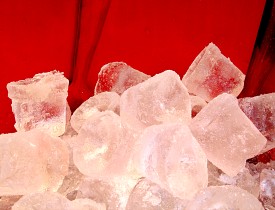Why Is My Freezer Not Cold Enough?
 Freezers tend to be so reliable that when they malfunction we actually have a hard time believing it. First you notice the ice cream is a little soft and assume that someone left the door ajar. Then you're puzzled by the realization that some items are frozen rock hard while others seem slightly less so. And yet, everything appears to be working as usual. So you wait. Or, you turn down the temperature all the way, then you wait.
Freezers tend to be so reliable that when they malfunction we actually have a hard time believing it. First you notice the ice cream is a little soft and assume that someone left the door ajar. Then you're puzzled by the realization that some items are frozen rock hard while others seem slightly less so. And yet, everything appears to be working as usual. So you wait. Or, you turn down the temperature all the way, then you wait.
Here's what you should do instead.
Check the Compressor
Once you've decided that it's not your imagination and your freezer really isn't cold enough, don't stand there with the door wide open, scratching your head. Don't turn the temperature knob all the way down, either, because that will likely make the problem worse. The first thing to do is make sure the compressor is turning on. If the appliance is humming away as usual, it's probably turning on.
Check the Freezer Air Circulation
Next, make sure the freezer isn't overloaded and that the evaporator fan is blowing air inside the freezer. Air needs to circulate around the compartment, and cramming it too full leads to problems. Then, make sure there's room for air circulation on the outside of the appliance, with at least 1 inch of space at the back and a few inches at the top. Finally, plan to cook some of the frozen stuff for dinner, just in case things don't work out as desired.
Check for Frost Buildup
Next, check for frost buildup. On an automatic-defrost unit, you can't tell whether the evaporator coils are frosted over, but if you see frost buildup along the walls of the freezer compartment, chances are the coils are choked with frost, restricting the airflow that cools the freezer. On a manual-defrost unit, you might see so much frost that you'll realize why your freezer space has been steadily dwindling.
Defrosting a manual unit will probably solve your problems. With an auto-defrost unit, defrosting manually can help you diagnose the cause and may get things working again, but you'll likely need a new part or two for a permanent fix.
Other Things to Check
Before you commit yourself to an old-school defrost, check out the following possible causes:
- Door seals—you shouldn't feel any cool air when running your hand along the edges of the closed door.
- Dirty coils—if you haven't cleaned behind the freezer in years, roll it out and vacuum the backside with a soft brush attachment, to remove dust and debris that restricts airflow.
- Ambient temperature—extremely hot weather can make a freezer warmer, especially if you're opening it a lot or frequently adding new items. In very cold weather, a freezer in the garage may heat up, since there isn't enough warm air for the system to work efficiently.
Time to Defrost?
A manual defrost is easy, if inconvenient and possibly messy:
1. Move everything that's worth saving to your neighbor's freezer or a picnic cooler with ice packs (eat or pitch the rest). If it's a freezer/refrigerator, you have to move all the fridge contents, too, since the cold comes from the freezer alone. If your freezer is full of frost, the air intake to the refrigerator could get iced over and blocked.
2. Lay a bunch of towels under the unit (even on automatic-defrost models, in case there's a lot of water).
3. Turn off the appliance.
4. Place bowls or other containers of hot water in the freezer to speed up defrosting and close the door. Replace hot water every hour or so as necessary.
5. Resist the temptation to chip away at the frost buildup with a knife; you could easily damage your freezer.
6. As the ice melts and loosens, remove chunks with your (gloved) hands, using a plastic spatula for a little gentle assistance as required.
7. When all the ice is gone, wipe the inside of the freezer dry with a towel.
8. Turn the unit back on to the normal temperature setting.
If the freezer is an auto-defrost and returns to its proper coldness, your trouble could be the defrost timer, defrost heater or defrost thermostat. There's also the unlikely possibility that you have a leak in a refrigerant line. Time to call a repair pro to take care of the problem.
This article was updated November 23, 2017.
Looking for a Pro? Call us (866) 441-6648

Handyman Average Costs
Handyman Services Experiences

Hot Tub Installation By The “BEST” Electrician

Circuit Breaker Replacement For A K9 Facility



